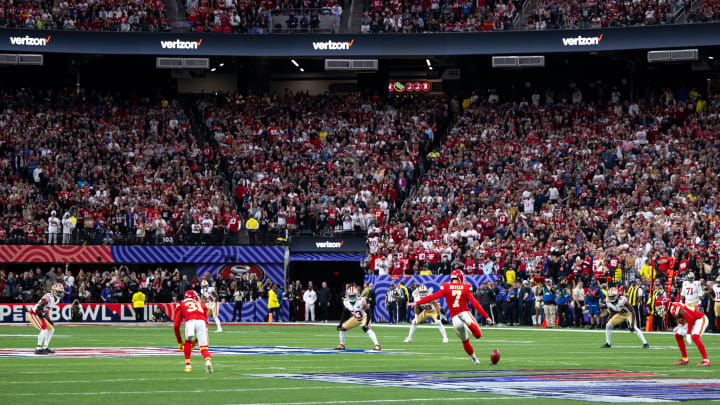New NFL Kickoff Rules Will Have Profound Impact in 2024

The NFL Competition Committee is meeting in Florida this week to decide what new rules will be introduced for the 2024 season. Yesterday they passed the controversial hip-drop tackle ban along with a few other minor changes. Today came with big news on that front. Reports emerged early Tuesday morning that the committee had passed new kickoff rules for next season. It's a radical departure from how NFL kickoffs have worked for the last decade and will have a significant impact on the game as a whole next season.
You can watch a full breakdown of what new kickoffs will look like here, the gist is this: Any kickoffs landing in the end zone or out of the back of the end zone now result in the offense getting the ball at the 35-yard line. Kickoffs landing before the end zone and are downed by the receiving team in the end zone lead to the offense getting the ball at the 20-yard line. Any kick that lands before the "landing zone" (from the goal line to the 20-yard line) gives the ball to the offense at the 40-yard line.
On returns, kickoff coverage teams are no longer able to start running until the ball is caught by a returner or the ball hits the ground. The same goes for kickoff return teams. Fair catches are no longer allowed.
The goal is to make kickoffs more exciting after several safety-related rules introduced over the years have pretty much killed the art of the kick return. This should definitely accomplish that. It's no longer advantageous for the kicking team to boot the ball out of the back of the end zone, as has become the most popular strategy in recent seasons. Instead they're far better off kicking the ball to where the returner is standing. Either he'll down the ball in the end zone, resulting in a standard touchback and possession at the 20-yard line, or he will attempt a return. Both are better options than accepting a touchback that gives the ball to the other team at the 35-yard line.
It is also now in the returning team's best interest to actually return the kickoff. That has been the biggest problem the NFL has failed to solve with changes to kickoffs over the years. It was never really an advantage to return it, even when the kick was well short of the goal line, because it was so rare for the return man to get past the 25-yard line. Even the best players in the return business struggled to consistently put the offense in a better position than they would've been with a touchback.
Now, returners don't have the option to fair catch if the ball is kicked short of the end zone. More importantly they will have a lot more room to work with. The coverage team can no longer move until the returner catches the ball, which should give him a good runway to build up speed before the bodies start flying in.
The one obvious downside to the rule change is how onside kicks are affected. Teams are no longer permitted to perform an onside kick whenever they please. Instead onside kicks are not allowed at all until the fourth quarter, at which point the kicking team is allowed to declare to the officials that they will be performing an onside kick.
The committee voted to institute these new rules for one season and see how it goes. There's a chance they try it and it doesn't work and the league reverts back to the old rules in 2025. But at least for 2024, it looks like kickoffs are going to be more important than they have been in years past.
Liam McKeone is a staff writer at The Big Lead.

Liam McKeone is a senior writer for the Breaking and Trending News team at Sports Illustrated. He has been in the industry as a content creator since 2017, and prior to joining SI in May 2024, McKeone worked for NBC Sports Boston and The Big Lead. In addition to his work as a writer, he has hosted the Press Pass Podcast covering sports media and The Big Stream covering pop culture. A graduate of Fordham University, he is always up for a good debate and enjoys loudly arguing about sports, rap music, books and video games. McKeone has been a member of the National Sports Media Association since 2020.
Follow liam_mckeone